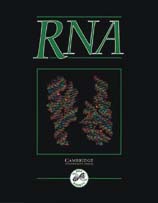Crossref Citations
This article has been cited by the following publications. This list is generated based on data provided by
Crossref.
Lopez, Pascal J
and
Séraphin, Bertrand
2000.
Uncoupling yeast intron recognition from transcription with recursive splicing.
EMBO reports,
Vol. 1,
Issue. 4,
p.
334.
Blandin, Gaëlle
Llorente, Bertrand
Malpertuy, Alain
Wincker, Patrick
Artiguenave, François
and
Dujon, Bernard
2000.
Genomic Exploration of the Hemiascomycetous Yeasts: 13. Pichia angusta.
FEBS Letters,
Vol. 487,
Issue. 1,
p.
76.
Bhattacharya, Debashish
Lutzoni, François
Reeb, Valérie
Simon, Dawn
Nason, John
and
Fernandez, Fernando
2000.
Widespread Occurrence of Spliceosomal Introns in the rDNA Genes of Ascomycetes.
Molecular Biology and Evolution,
Vol. 17,
Issue. 12,
p.
1971.
Hirose, Yutaka
and
Manley, James L.
2000.
RNA polymerase II and the integration of nuclear events.
Genes & Development,
Vol. 14,
Issue. 12,
p.
1415.
Stibitz, Thomas B.
Keeling, Patrick J.
and
Bhattacharya, Debashish
2000.
Symbiotic Origin of a Novel Actin Gene in the Cryptophyte Pyrenomonas helgolandii.
Molecular Biology and Evolution,
Vol. 17,
Issue. 11,
p.
1731.
Brow, David A.
2002.
Allosteric Cascade of Spliceosome Activation.
Annual Review of Genetics,
Vol. 36,
Issue. 1,
p.
333.
Furger, Andre
Binnie, Justin M. O‘Sullivan, Alexandra
Lee, Barbara A.
and
Proudfoot, Nick J.
2002.
Promoter proximal splice sites enhance transcription.
Genes & Development,
Vol. 16,
Issue. 21,
p.
2792.
Libri, Domenico
Ducongé, Frédéric
Levy, Laurence
and
Vinauger, Marion
2002.
A Role for the Ψ-U Mismatch in the Recognition of the 5′ Splice Site of Yeast Introns by the U1 Small Nuclear Ribonucleoprotein Particle.
Journal of Biological Chemistry,
Vol. 277,
Issue. 20,
p.
18173.
Stevens, Scott W.
and
Abelson, John
2002.
Guide to Yeast Genetics and Molecular and Cell Biology Part C.
Vol. 351,
Issue. ,
p.
200.
Hieronymus, Haley
and
Silver, Pamela A.
2003.
Genome-wide analysis of RNA–protein interactions illustrates specificity of the mRNA export machinery.
Nature Genetics,
Vol. 33,
Issue. 2,
p.
155.
Barrass, J.David
and
Beggs, Jean D.
2003.
Splicing goes global.
Trends in Genetics,
Vol. 19,
Issue. 6,
p.
295.
Bhattacharya, Debashish
Simon, Dawn
Huang, Jian
Cannone, Jamie J
and
Gutell, Robin R
2003.
The exon context and distribution of Euascomycetes rRNA spliceosomal introns.
BMC Evolutionary Biology,
Vol. 3,
Issue. 1,
Kuhn, Andreas N.
and
Käufer, Norbert F.
2003.
Pre-mRNA splicing in Schizosaccharomyces pombe.
Current Genetics,
Vol. 42,
Issue. 5,
p.
241.
Akashi, Hiroshi
2003.
Translational Selection and Yeast Proteome Evolution.
Genetics,
Vol. 164,
Issue. 4,
p.
1291.
GIBBS, M
REEVES, R
SUNNA, A
and
BERGQUIST, P
2004.
A yeast intron as a translational terminator in a plasmid shuttle vector.
FEMS Yeast Research,
Vol. 4,
Issue. 6,
p.
573.
Dembla-Rajpal, Neetu
Seipelt, Rebecca
Wang, Qiang
and
Rymond, Brian C.
2004.
Proteasome inhibition alters the transcription of multiple yeast genes.
Biochimica et Biophysica Acta (BBA) - Gene Structure and Expression,
Vol. 1680,
Issue. 1,
p.
34.
Shin, Chanseok
and
Manley, James L.
2004.
Cell signalling and the control of pre-mRNA splicing.
Nature Reviews Molecular Cell Biology,
Vol. 5,
Issue. 9,
p.
727.
Haugen, Peik
Reeb, Valérie
Lutzoni, François
and
Bhattacharya, Debashish
2004.
The Evolution of Homing Endonuclease Genes and Group I Introns in Nuclear rDNA.
Molecular Biology and Evolution,
Vol. 21,
Issue. 1,
p.
129.
Kuhn, Andreas N.
and
Käufer, Norbert E.
2004.
The Molecular Biology of Schizosaccharomyces pombe.
p.
353.
CARMEL, IDO
TAL, SAAR
VIG, IDA
and
AST, GIL
2004.
Comparative analysis detects dependencies among the 5′ splice-site positions.
RNA,
Vol. 10,
Issue. 5,
p.
828.

